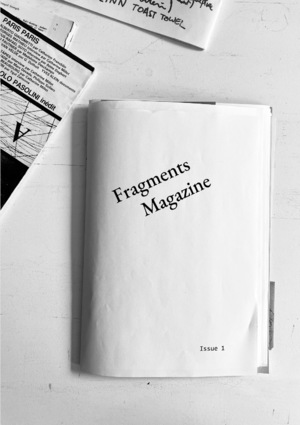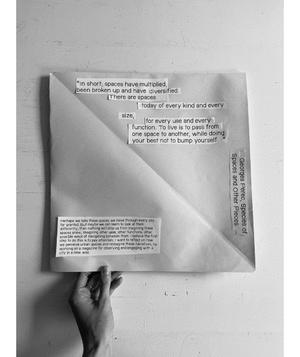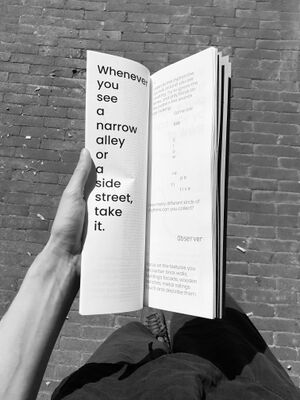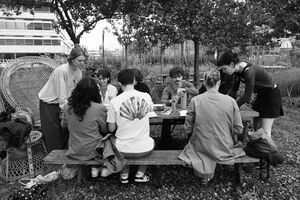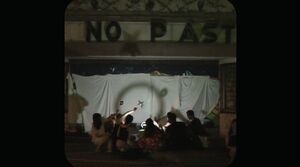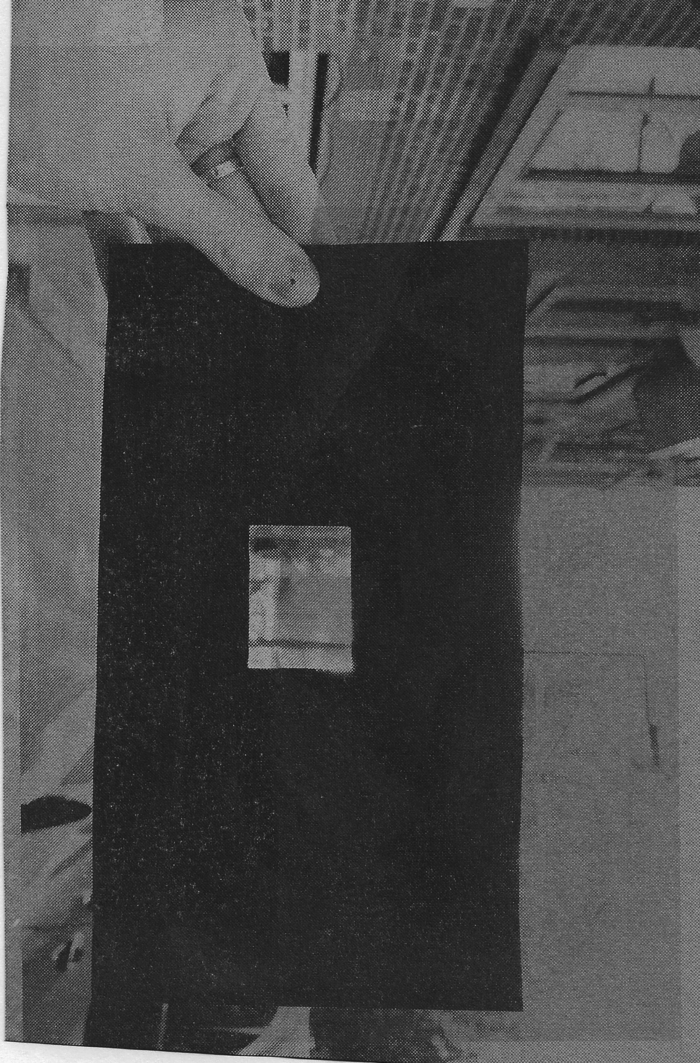User:Mania/Fake assesment: Difference between revisions
| (2 intermediate revisions by the same user not shown) | |||
| Line 15: | Line 15: | ||
[[File:Screenshot 2024-11-26 at 12.35.25.png|thumb]] | [[File:Screenshot 2024-11-26 at 12.35.25.png|thumb]] | ||
[[File:Kite.gif|thumb|chapter of my thesis unfolding into a kite]] | [[File:Kite.gif|thumb|chapter of my thesis unfolding into a kite]] | ||
| Line 26: | Line 26: | ||
For the magazine I utilize the exploration of the relationship between scripted and spontaneous behaviour, the tension between chance and control, and how the simple tool or a script can enhance unpredictability, stimulate imagination and encourage us to observe space with curiosity, as if we were looking from someone else's perspective. Treating this as a foundation, I want to experiment more with printed matter, forming scripts and playing with the physicality of paper, to understand how a magazine can shape the way we perceive our surroundings. This project studies how even the simplest tools, which impose certain limitations, can open us to unexpected opportunities and seeing our surroundings in a new way. It considers magazines as shared resources that help us observe, see differently, and encourage us to question reality. I want to explore the role that self-publishing and distribution might play in this context, by thinking about ways I’ll publish my project to create networks of exchange. | For the magazine I utilize the exploration of the relationship between scripted and spontaneous behaviour, the tension between chance and control, and how the simple tool or a script can enhance unpredictability, stimulate imagination and encourage us to observe space with curiosity, as if we were looking from someone else's perspective. Treating this as a foundation, I want to experiment more with printed matter, forming scripts and playing with the physicality of paper, to understand how a magazine can shape the way we perceive our surroundings. This project studies how even the simplest tools, which impose certain limitations, can open us to unexpected opportunities and seeing our surroundings in a new way. It considers magazines as shared resources that help us observe, see differently, and encourage us to question reality. I want to explore the role that self-publishing and distribution might play in this context, by thinking about ways I’ll publish my project to create networks of exchange. | ||
== '' | == ''Why do you want to make it?'' == | ||
I want to combine the topic of urban space with the format I love—publications, specifically a magazine. I'm curious to explore what a magazine could be if I think of it as something to be read outdoors or used as a tool, and what it could bring to urban spaces. After completing the Scripts to Read the City project, I find the question of what perspectives artistic research can bring to urban spaces very relevant. I love cities and I am interested in projects rooted in this context. | |||
Previous practice | |||
This summer, I attended a summer school focused on urban space as a place for various (un)learning practices, activating different modes of knowing, sensing, and being/becoming together. I met people from urban studies, researchers, and other artists interested in participatory urban interventions, and I think that these connections could also help me now, by providing constructive conversations. | |||
Revision as of 17:20, 26 November 2024
Project proposal
What do you want to make?
My final project will be a magazine (Fragments Magazine) that actively engages readers in experiencing and reinterpreting the spaces they inhabit. What makes Fragments a magazine is its continuity and collaborative approach, utilizing workshops to create content, which outcomes are meant to invite performative interactions with space. I want to understand how a magazine that is meant to be read or even played outside can influence the way we perceive our surroundings. Therefore Fragments magazine is a repository for paper-based tools that redefines what a magazine is commonly understood to be. By actively existing in public space, it becomes an interface for specific actions and experiences, rather than just a container.
Fragments is a magzine about seeing our cities piece by piece and looking with with curious eyes. It's published intermittently and meant to be read outside. Fragments publications are printed matter supporting performative interactions with space.
Relation to previous practice
Fragments Magazine will build upon the experience gained in previous semesters. Starting with the research into neighborhoods as learning environments, which I began in the second semester and drawing heavily from the last Special Issue. Fragments Magazine continues the exploration of the theme undertaken during the Scripts to Read the City project, where I tried to create a series of scripts that encourage spontaneous behavior and exploration of space. The result of the work was a device for reading the city and a guide containing scripts that encourage the discovery of opportunities we might encounter and the viewing of the city from someone else’s perspective. Additionally, as part of the project we conducted a series of workshops in which participants wrote their own scripts, and then we walked around the city according to a script written by someone else.
For the magazine I utilize the exploration of the relationship between scripted and spontaneous behaviour, the tension between chance and control, and how the simple tool or a script can enhance unpredictability, stimulate imagination and encourage us to observe space with curiosity, as if we were looking from someone else's perspective. Treating this as a foundation, I want to experiment more with printed matter, forming scripts and playing with the physicality of paper, to understand how a magazine can shape the way we perceive our surroundings. This project studies how even the simplest tools, which impose certain limitations, can open us to unexpected opportunities and seeing our surroundings in a new way. It considers magazines as shared resources that help us observe, see differently, and encourage us to question reality. I want to explore the role that self-publishing and distribution might play in this context, by thinking about ways I’ll publish my project to create networks of exchange.
Why do you want to make it?
I want to combine the topic of urban space with the format I love—publications, specifically a magazine. I'm curious to explore what a magazine could be if I think of it as something to be read outdoors or used as a tool, and what it could bring to urban spaces. After completing the Scripts to Read the City project, I find the question of what perspectives artistic research can bring to urban spaces very relevant. I love cities and I am interested in projects rooted in this context.
Previous practice
This summer, I attended a summer school focused on urban space as a place for various (un)learning practices, activating different modes of knowing, sensing, and being/becoming together. I met people from urban studies, researchers, and other artists interested in participatory urban interventions, and I think that these connections could also help me now, by providing constructive conversations.
Who can help you and how?
I can definitely count on the people from De Boog—they’re also interested in print and always look for ways to do things together. I’m planning to run a workshop there, and their help will be very valuable. I think that if I go forward with an open call for the magazine, participants I met during the Viadrinicum summer school might be interested in taking part in it. I just thought of reaching out to some of them to conduct short interviews, which could accually be incredibly inspiring for finding the right approach to public space interventions in terms of ways to publish the magazine. Other than that I really need help from tutors to master web-to-print. And most importantly some emotional support from other students and friends.
Broader context
Directing attention and performative methods for seeing and engaging with the surrounding. In the thesis I’ll give these methods context historically and culturally. I’m deriving from how cultural and technological forces shape ways of seeing as well as interventions in urban spaces that provoke new ways of seeing and interacting with the city.
What is your time table?
BLOCK 1
September, October, November
Content
- Participating in Zine festivals, leading workshop in Groningen
- Experiments with camera obscura, paper frames, photographs and collages
- Public moment
- Finalizing project proposal and research outline
- Coloqium - testing workshop format 1
- Experiment with the formats of the magazine to exist outside
- Prepare the schedule
- Research into existing magazines before I start designing
- The question what I focus on (is it image heavy, repository of tool, do I include cultural context in a written form?)
BLOCK 2December, January, February
Content
- Assesment
- workshop 2 - De Boog
- workshop 3
Design draft
- idea for possible formats to actively exist outdoors
- practice practice practice CSS (web to print)
BLOCK 3March, April, May
Design
- Overview of the content (break everything to see what comes page by page )
- How to print cost-effectively and how to get the most out of my format
- Material
Production
- printing
- binding
- fixing
FINAL MONTHJune
Distribution
- Activation in public space
- Documentation
- Celebration
References:
Johanathan Crary, Techniques of the Observer
Lorraine Daston and Peter Galison Objectivity, MIT, (2007)
Georges Perec, Species of Spaces and Other Pieces
Guy Debord, Report on the Construction of Situations(1957)
The Situationist International (SI) - Situationist maps, like The Naked City (1957), fragment Paris into emotional zones, challenging the conventional ways cities are navigated and understood.
Soda Kazhiro, Why I Make Documentaries, on Observational Filmmaking
Kevin Lynch, The Image of the City
Italo Calvino, Invisible Cities
Rebecca Solnit, Infinite City: A San Francisco Atlas (2010)
Jane Jacobs , The Death and Life of Great American Cities (1961) - Jacobs emphasized the importance of "eyes on the street" and mixed-use urban areas, critiquing large-scale modernist urban planning in favor of organic, community-oriented design.
Dziga Vertov – Man with a Movie Camera (1929)
Agnes Varda – Daguerreotypes (1976)
Frederick Wiseman – In Jackson Heights (2015)

